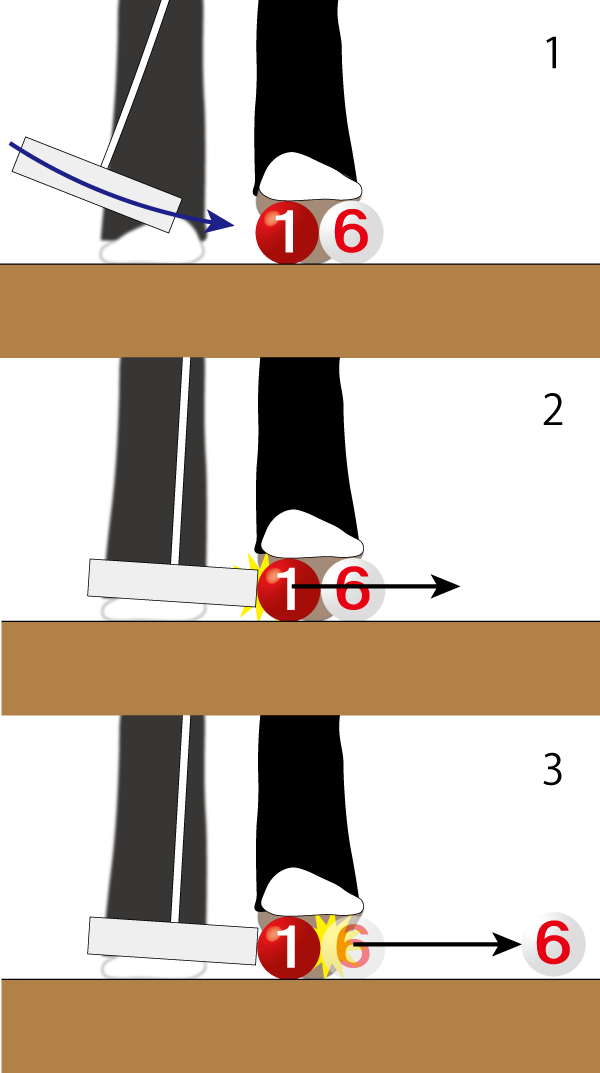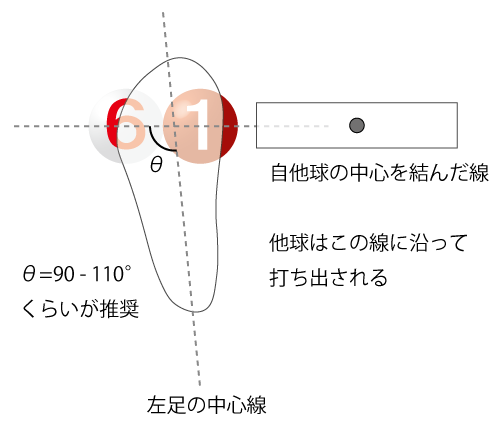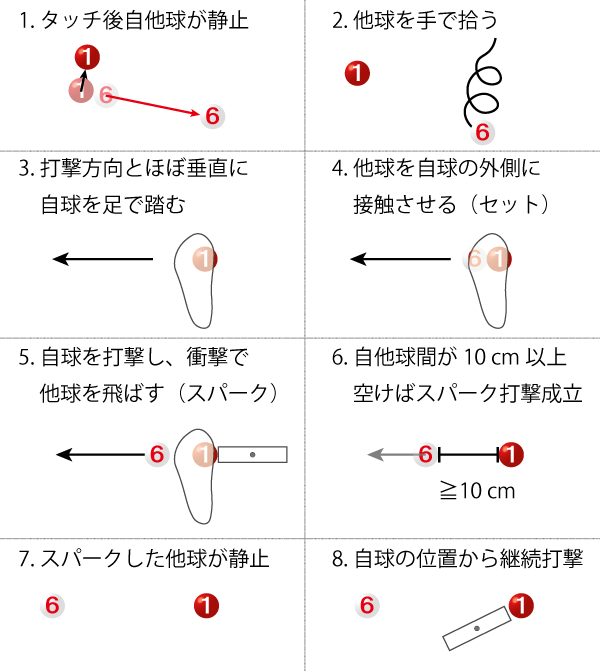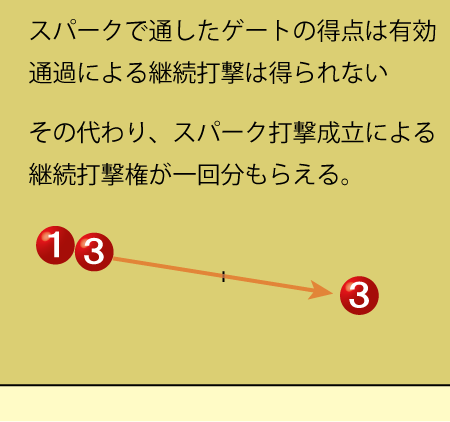>>1.Basics and rules >>1.2.Equipment and rules >>1.2.3.Gateball rules(3)(prev|next)
Gateball rules(3) Touch and Sparking
In the previous section, we learned how to gain points and how to calculate the team's score. We also discussed the right for continuous stroke after a successful pass. In this section, I am going to talk about two very critical plays; Touch and Sparking. You will be able to play gateball after reading through this section. Hang on!
I will briefly explain the summary of this section to make the reader easily navigate the following content. In short, the stroker will gain the right to spark after touching the ball. Sparking is a special stroking method which enables the stroker to indirectly strike the touched ball by placing the stroker's ball and the touched ball together. After making a successful sparking, the stroker will gain the right for continuous stroke as he/she gained after a successful pass.
Touch: the stroker's ball is stroked and moved to touch another ball. That collision is called touch.
Sparking: the stroker's ball and the touched ball are placed in contact under his/her foot and the touched ball is indirectly moved by striking the stroker's ball.
The definition of touch is as follows. When the stroker's in-ball is stroked and moved to hit other balls in the court, that collision is called touch. In-ball is a ball in the inner field after having passed through the first gate. In other words, touch is to make the stroker's in-ball collide with the other ball in the court by stroking.

Procedure of touch: Example.1 Red number one touches white number six. 1. The stroker's ball (red one) is stroked in the direction of the other ball, white six. 2. The stroker's ball and the touched ball is in contact. 3. The momentum of the stroker's ball is distributed to the two balls. The direction and the distance of the motion is shown in black for the stroker's ball and red for the touched ball. 4. The stroker's ball and the touched ball stop.The following sparking must be done where the stroker's ball stopped.
Given that the stroker's ball is A and the touched ball is B, we say that "A touched B" or simply "touch B". When a touch happens, and only when both the stroker's ball and the touched ball remain in the inner field, the stroker will gain the right for sparking. Actually, players cannnot refuse the right to spark. It is a duty rather than a right.
Sparking is a special method for indirectly stroking the touched ball. The stroker picks up the touched ball and step on the stroker's ball and place the touched ball in contact with his/her own ball. Players are not allowed to directly stroke the touched ball but hitting stepped his/her own ball is permitted. The touched ball will be released from the foot by the impact of hitting his/her own ball. With this technique, the stroker can move the touched ball anywhere he/she wants. Sparking must be done where the stroker's ball stopped. To clarify, the procedure is summarized in the figure below. Some of you may have seen this before.

Sparking of the right-handed stroker (side view): Red one touched white six. The stroker have already picked up the touched ball. 1. The stroker steps on his/her own ball with left foot and place the touched ball in contact on the left side. The stroker must hold two balls firmly under the foot. 2. Stroke his/her own ball under the foot. 3. The impact momentum is transferred to the other ball and it is released from the foot. The stroker's ball remains under the foot.

Sparking of the right-handed stroker (top view): The position of the foot is typically as shown in the figure. The direction of the other ball's movement is along the line which connects the centers of the balls. When you step on the balls, make sure that your heel is on the ground. Although the weight distribution to two balls varies from player to player, it is typically recommended that about 70% of weight on the stroker's ball and the rest 30 % on the other ball. The angle between the midline of the left foot and the line which skewers two balls should be around 90 to 110 degrees.
- To make the stroker's in-ball collide with the other in-ball by stroking is called touch.
- After successful touch, the stroker must spark the touched ball where his/her ball stopped.
How to spark. Benefits of sparking.
The sparking procedure is as follows. First, pick up the touched ball and step on the stroker's ball with left foot if the stroker is right-handed. The angle of the foot is perpendicular to the direction you want to send the other ball in. The stroker's ball is placed on the right side and the other ball on the left side so that two balls are in contact. Making two balls close together under the foot is called setting. The notion of setting is very important for the proper refereeing.
After setting, the stroker can strike his/her own ball with the mallet. The momentum given by stroking is transferred to the touched ball which is firmly held under the foot because the stroker's ball and the touched ball are in tight contact. Thus, the stroker can move the touched ball where he/she wants if skillful. Controlling the other ball's position is obviously a merit of sparking. If the distance between sparked ball (i.e. the touched ball) and the stroker's ball exceeds 10 cm, it is regarded as a successful sparking. After a successful sparking, the stroker will gain the right for continuous stroke! This is the other merit of sparking. I am going to talk about the unsuccessful sparking or sparking fouls in other section.
Sparking procedure is summarized in the figure. Touch→Pick up the touched ball→Step on the stroker's ball and place the other ball outside of the foot. Make sure that two balls are in tight contact (setting).→Release the other ball from the foot by the impact of stroking. (This step is sparking in narrow sense)→After making a successful sparking, the stroker will gain the right for continuous stroke.

Procedure of sparking: Red one touched white six. 1. All balls stop after making a touch. 2. Pick up the touched ball. 3. Step on the stroker's ball so that the foot is perpendicular to the direction of the sparking. This step should be done after deciding where to send the other ball. The stroker's ball should be firmly fixed with the inside of the left foot. 4. Place the touched ball to the outside of the stroker's ball and move it so that the two balls are in tight contact. This process is called setting. If there is a gap between two balls, the momentum is not transferred efficiently. 5. Stroke the stepped your own ball with mallet. The other ball is released from the foot. This step is called sparking. 6. If the distance between the sparked ball and the stroker's ball is more than 10 cm, it is regarded as a successful sparking. 7. The stroker's ball and all other balls stop. 8. The stroker gains the right for continuous stroke from where the stroker's ball is.
I will show how to use sparking during the actual game in tactics section later. Here I will briefly explain why sparking is important for tactics. Touch and sparking can move the other balls as the stroker wants. If the touched ball is your team's ball, the stroker can send it where it can easily pass the gate. On the other hand, if the touched ball is opponent's ball, the stroker can send it to the position very far from the gate or even outer field! The stroker can gain the right for continuous stroke after making a successful sparking. This right for continuous stroke itself is very attractive because he/she can continue playing as long as he/she touches the other balls. The stroker can control the position of the other balls as if he/she were a conductor. In addition, all scoring plays by sparking (such as passing the gate and making Agari) are valid! You can pass the gate by yourself or let your teammates spark through the gate.

All scoring plays by sparking are valid. When the stroker sparks through the touched ball, he/she will not gain the right for continuous stroke by passing the gate. He/she will gain it by making a successful sparking instead. In this case, no matter whether red one can succeed in sparking red three through the gate, red one player will gain the right for continuous stroke.
- When the distance between the sparked ball and the stroker's ball is larger than 10 cm, it is regarded as a successful sparking.
- After making a successful sparking, the stroker will gain the right for continuous stroke.
- All scoring plays (such as passing the gate or making Agari) by sparking are valid.
Help your team and get in the way of the opponent.
Touch and sparking enables you to move the touched balls at your will. You can help your teammates or get in the way of the opponent by touch and sparking. I think this is the most interesting part of gateball.
The stroker can have control over the touched ball. Few games allow players to control over the opponent's pieces. This characteristic makes gateball complex and profound.
Imagine there are no touch and sparking. Gateball would have become a very boring game. Ten balls would have rushed to the next gate separately like golf (no hostility). Some beginners may hesitate to have control over the other's ball... don't care! It is a 100% valid play. No one will blame you. Touch many balls, spark a lot, that is gateball.
- The stroker can take temporary control over the other ball by touch and sparking.
- Touch and sparking make gateball more interesting.
